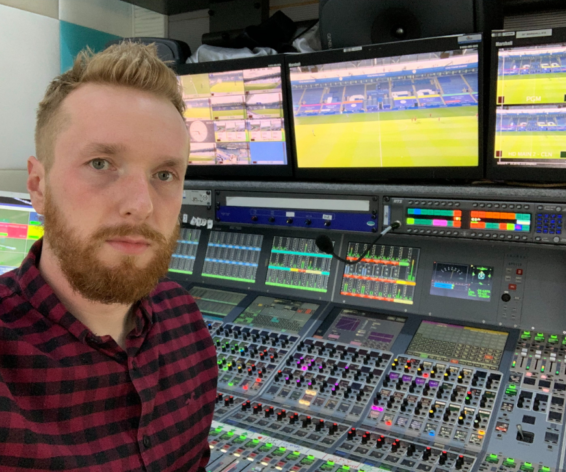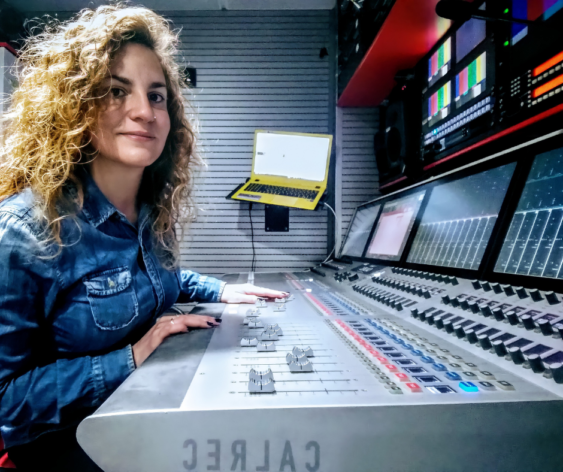Canada-based Myles Carlyle was exposed to the world of broadcast audio at a young age. As an audio engineer, he mixes a variety of live sports and worked at the 2018 Winter Olympics in South Korea. Check out what he thinks about the evolution of broadcast audio in a Covid world and the rise of AoIP and remote working.
1. Tell us about your path to professional audio; how did you get started and what drew you to the field?
I don’t want to say it was an industry I was meant to be in, rather one that I could not escape. I am the fourth generation in my family who’s worked in live broadcasting. My great grandfather was a pioneer at CBC radio; my grandfather was an Editor, Producer and a Director for CTV; and my father became an Audio Engineer in the very same field. I’ve been around live broadcasting my entire life. Right out of high school I started volunteering at Much Music in Toronto, where, at the time a lot of popular musical acts would perform. I was asked to mic up a set of drums and that just got the blood flowing! From there, I interned at a post-production house that would do re-record engineering of major films and television series — a completely different mindset and workflow but equally fascinating.
I played sports my whole life, and after seeing what my father did at his job at a young age, it made me curious. How did they get sounds from a location far from the source to the viewers at home? Unlike film/television, live entertainment can be “unscripted” and anything can happen. I suppose the rush is what got me.

2. How did you become an Audio Engineer at Dome Productions and Maple Leaf Sports & Entertainment?
Once out of school, I contacted Maple Leaf Sports & Entertainment to see if there was an opportunity for me. They offered me the chance to shadow the broadcast crew and give a hand wherever needed. I would sneak into the audio room in the truck and introduce myself to whoever was mixing the show that day and ask as many questions as they were willing to answer. I was intrigued by audio the minute I stepped on site. From there, I was asked to work as a Boom Op for the Toronto Raptors broadcast. I would go in during time outs and media scrums with a large boom trying to get whatever sound bites I could for the show. I volunteered for a few years before I was asked to be an Audio Assistant for the majority of NHL and NBA games.
Any free time I had on show days was spent in the audio room trying to absorb as much information as I could. I would watch Audio Engineers perform their craft and try to time my questions carefully so that I didn’t distract them from what they were doing. Many of them were very kind in showing me their tricks of the trade. I was asked to mix a few small-scale shows here and there, dipping my feet in a large pool, so to speak. As time went on, I let it be known I wanted to be a mixer, and I was given more opportunities to mix larger-scale productions.
3. What does your role entail with each position? Do you freelance for other companies?
I am still relatively young with a lot to learn, so I still do a lot of audio assist work, mainly for the Toronto Raptors. I have been doing that for eight years, steadily. We have a lot of different audio requirements with their broadcasts. I set up all the field effects mics in the arena (i.e., basket, key, crowds, surrounding court mics) in the best position possible, aimed to get all we can out of the microphones. Head Mixer for the Raptors, John Hunter, has had a major influence on me, and we have created a solid workflow. This has allowed me to experiment on mic placement and different techniques. Setting up positions for on-air announcers and reporters is an essential part of the job. Setting up their positions to be as functional and as accessible to me, while making the area comfortable for them, is crucial.
Mixing is a different animal. Again, I’m one of the youngest broadcast mixers in the country, and I am still ironing out a workflow. I have watched so many engineers through the years and I have tried to take on many of their ideas and implement them in ways that work with my audio philosophy. I try and create a solid leg to stand on when I go into a show, and that is always pre-planning my day with quality paperwork like notes on what I need, and where to put them. Trusting my Audio Assistants is very important to me. As an A2 myself, I never enjoyed being made to feel that I couldn’t be trusted on the field by my Head Engineer. They are my lifeline, and I have to have faith in them and give them all the information I can for them to succeed. If I fail them, they fail me.
I always like to set up my console before I consider making my first patch. If I have solid paperwork with me and a console that is built in a way that I feel comfortable using it, then I’m at ease.
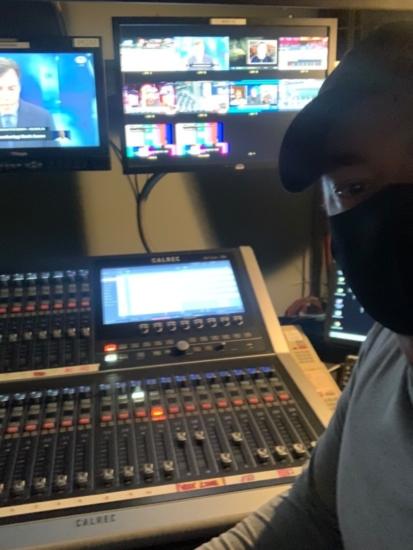
4. We understand you’ve worked at the 2018 Winter Olympics in South Korea. Please tell us about that experience and the work that you did.
The Olympic Games is something I’ve always wanted to experience! South Korea was the place that said, “Well you wanted it. Here it is!” I have never travelled that far from home before, nor have I ever been away for as long as I was; not to mention dealing with a language barrier and a foreign script I couldn’t read. There were a lot of adjustments that had to be made. I was working hockey at the Kwandong Hockey Centre, which had a Canadian-based crew and an event I was familiar with (friendly faces made the experience much easier). For this large-scale event, the audio department was responsible for all international sound. We were given a crate load of microphones to work with and implement in the arena. I don’t think there was an inch of that ice that wasn’t covered by microphones. It was a great experience and I am really happy I was able to be a part of it.
5. When did you first start working with Calrec and for how long have you been using their technology?
The first Calrec product I remember using was a Calrec M3 mini mixer. I think it had around 28 inputs. I used it on a small skiing shoot in Ontario in 2011. I remember the crunch I got from the skiers flying down the slope. The mic pres sounded great. Since then, I have worked with almost all of the Calrec consoles. The S2 and I still meet from time to time and it’s always fun when I go back to the analogue world. This was what I was trained on, and once I got into the workplace I had to learn digital from scratch. The Alpha platform is one I’ve probably had the most experience with. I have mixed soccer, hockey, basketball and lacrosse on the Omega, Alpha and Sigma consoles. They are workhorses and to this day the Sigma is one of my favourite consoles; I still use it on a regular basis. What makes it great is that everything is within arm’s reach, and the layout is designed in the way I like to work.
The Artemis and Apollo have become industry-standard audio consoles. I use them a fair amount and the transition has been seamless. In the last five years, I’ve also used Calrec’s compact Brio console quite a bit and I have to say it’s a fun little board. It has power and a quality user interface that really meshes with a broadcast engineer’s mindset.
6. We understand you’re using Calrec’s Brio to mix the NBA show Court Surfing in Canada. What exactly does this type of work involve?
The premise of the show ‘Court Surfing’ is kind of like the NFL’s Redzone – a highlights show. There are up to 10 NBA games in a given night, and our show brings in the broadcasts of all those games. We bounce around the entire league, cutting the fluff out of each game and showing those big moments that viewers want to see.
Our studio receives the broadcasts of these games with video and embedded audio, and I implement those sources into the Calrec Brio console. We have two hosts on the show that talk throughout the games and discuss the latest NBA news. I have two hosts with lavs commenting on the game, while the viewers watch various NBA coverage. In those moments, I am fading in and out the game audio that they are discussing along with the other show elements like music, replay machines, graphic and switcher triggers.
Like I said, I love the Brio. I can get from where I need to go without even thinking about it. I have made that console my own and I really enjoy it.
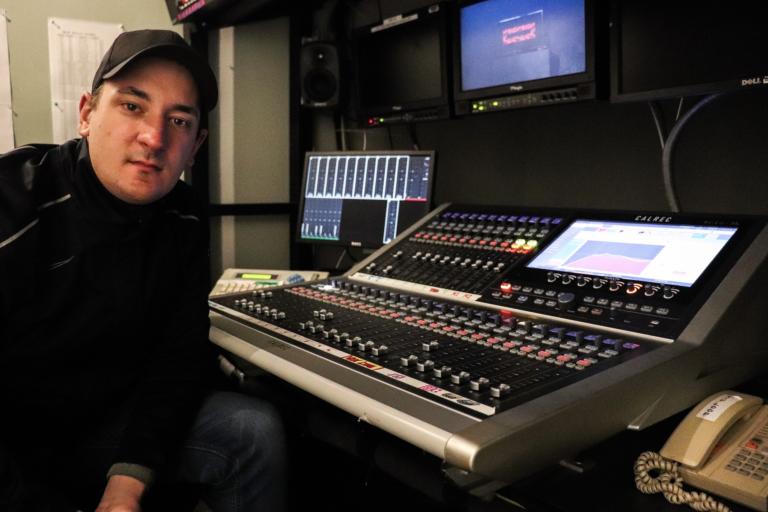
7. What differentiates Calrec from other console makers in the industry and what are your favorite things about using the Brio?
The biggest difference that I have always noticed with Calrec (and with the Brio especially) is that its design is very practical and well thought out. From the moment you power it on and look at it for the first time, a trained eye can look at each menu setting and user function and easily understand the path. A lot of other compact digital consoles I have worked with have almost created their own language, which makes things challenging. I can honestly say that the Brio is the first digital console I have worked on where I have not had to bust open a manual to make it work.
8. Can you please give an example or two where the Brio’s features stood out and really helped you get the job done?
At first, it took a while to adjust to the separate screen needed for monitoring levels. It reminded me of when I worked in a studio. I now have an entire screen dedicated to monitoring, while being completely separate from my workspace.
Certainly, in a pinch, the bus and output section of the Brio is a mainstay on my screen. Being able to quickly tone out each individual bus multiple times on show day is a real timesaver for sure.
9. What have been the key technological milestones you’ve witnessed in your time in broadcast audio and how have they changed what you do/how you work?
Well, as much as I don’t want to say I have “seen it all,” many colleagues of mine who have much more experience than me can certainly say this with a clear conscience. We have all adapted from many forms of mixing audio, like mixing in stereo, to 5.1, to Dolby Atmos. The only mix I have not seen or been a part of is mono. When I started, digital was just becoming the norm and I saw it evolve and grow pretty quickly. I still worked on some shoots that were analogue based; long runs of heavy copper cable, to now a fiber pair that can hold all the ins and outs needed for some of the shows I do.
Now with audio over IP, we have so much flexibility with signal flow with almost no latency – it’s pretty wild!
Workflow-wise, it feels sort of the same. I go in with the same mindset. Meaning, the show needs to get to air with these sources. I need to send these sources to these places. The goal is the same and the way it’s done is close to the same, it’s just that the technology has changed.
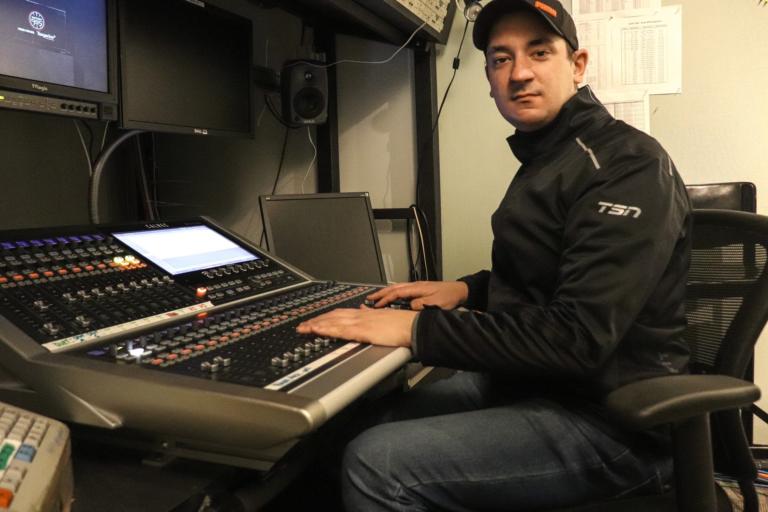
10. The industry is moving toward IP-based solutions for audio control, networking and distribution. What is your experience with these changes and how are you experimenting/working with IP?
I have been put on a few shows that are truly IP based. Canada is still building an infrastructure to truly test the capability of AoIP, but it is getting there. I do REMI shows where production is in a studio far from the source and I receive signals via IP, and the latency, or lack thereof, is pretty astonishing. I try not to overthink it but rather, I look at it as just another source of transportation to me. Luckily in school, my teachers taught signal flow – “Where there is an A, there is a B” and “Every in has an out” type of stuff. These are things that may get lost on the new generation.
11. How is COVID-19 affecting your work at the moment? How has it significantly impacted a recent project that you’ve done?
I think it has affected everyone in the industry. It has caused uncertainty and brought much more awareness to mental health. It has also made me think about my long-term goals. I was out of work for quite a while, though I consider myself one of the lucky ones because I was back at work a lot sooner than many others I know in the business.
I work hand-in-hand with on-air announcers, athletes, fellow technicians on the day-to-day stuff. We work long hours and your colleagues sort of become your other family. Every day you may come in and continue a conversation you had weeks before. But now times are different. New social distancing measures have been put into place to keep us safe, though admittedly, they have made our jobs rather difficult. Generally, I set up an announcer’s position with my personal headset for testing. Once the announcers arrive to call the game, if they are experiencing any issues with their own headsets, typically I would grab their headset to solve any issues. But with Covid, I can’t do that anymore. But hey, we’ve all had to make adjustments to stay safe and we’ve all had to find ways to resolve issues while following Covid protocols.
12. How do you see audio evolving in the next five years?
I’m seeing some major developments in the NFL and NBA where announcers are calling the game from their homes. Now is that the new norm? It’s hard to say. This might be a more economical approach.
With so many ways to consume media, there will always be a need for quality audio. I say that, even though with this pandemic we have accepted Zoom calls over laptop microphones. However, I think audio is becoming even more important. I believe sports fans want more access to the athletes. They follow them on social media and they feel they have a personal connection with them. Athletes wearing microphones during the game is really catching on now that we have very compact wireless transmitters. I’m normally not an optimist, but when it comes to the growth of audio, I feel confident it is going to grow in a good way!
Missed our previous craft interviews?
Click the links below to read about our latest craft interviews.



